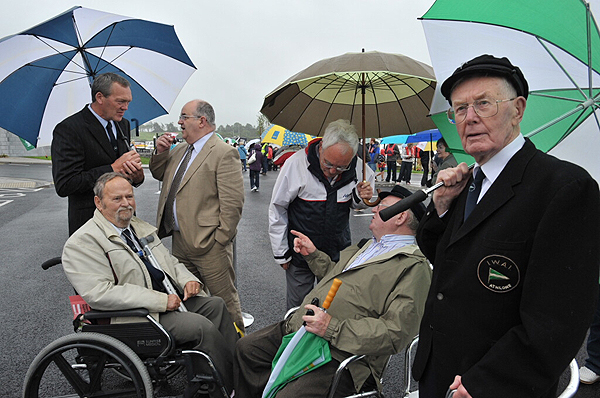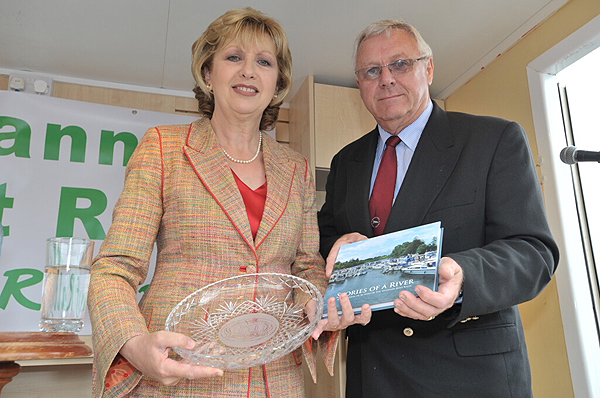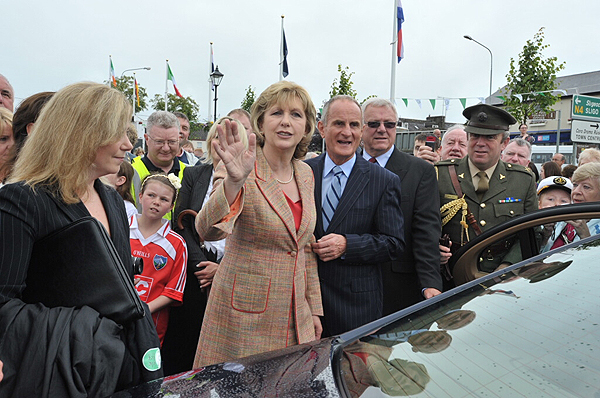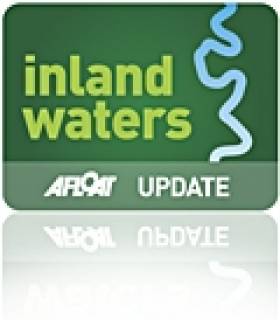Displaying items by tag: President McAleese
President McAleese Opens 50th Shannon Boat Rally (Pics here)
Over 500 boaters gathered to welcome the President and Dr McAleese. President of the Inland Waterways Association of Ireland. Inland Association president Paul Garland said “The McAleese family is no stranger to the River Shannon. Most of us have had their friendly wave as they pass by and I know that they share that special joy we all have by simply being on the river”
Scroll down for Images
On a typical wet Irish morning, President McAleese officially opened the Inland Waterways Association of Ireland 50th Shannon Boat Rally, Saturday 24th July in Carrick on Shannon.
In her address, the President recalled her first boating experience on Lough Ree – “Martin and I were only baby boaters at that time – as we met our first four foot wave, our son Justin – who had little faith in our boating skills – called on us to contact the coastguard!” Reflecting on the significance of the River Shannon to the towns, villages and communities along its route, the President said “from this silver garland – our river Shannon – you see Ireland from a different perspective”
Over 140 boats, barges and sailing cruisers crewed by over 500 people will spend the next two weeks holidaying on the River Shannon bringing much needed business to the many small towns and villages along the banks of the Shannon. The two largest towns on the river - Carrick on Shannon and Athlone along with Waterways Ireland – have invested significantly in the river’s navigation, harbours and facilities which makes boating a pleasure for the Shannon Rally. The Shannon Rally goes from strength to strength said Commodore of the 50th rally, Donal O’Siocháin, with more and more people choosing to holiday in Ireland on our rivers – year on year.
President McAleese concluded by thanking the IWAI volunteers – “the custodians of the river, the champions of the river – who cherish the river – they have taught us to be careful of the river – to keep it for the next generation.
Commodore Donal O’Siocháin presented President McAleese a specially commissioned Leitrim crystal plate engraved with the rally emblem and a copy of the newly launched book “Stories of a River” - commemorating 50 years of the Shannon Boat Rally. Vice Commodore Tom Meegan presented Dr McAleese with a bottle of single malt Irish whiskey – one of only 292 bottles matured at Kilbeggan’s Locke’s Distillery especially for the Shannon Rally.
The event was attended by Frank Dolan Cathaoirleach Leitrim County Council, County Manager Leitrim County Council - Jackie Maguire, and Waterways Ireland Chief Executive Waterways Ireland - John Martin.
The full text of IWAI President, Paul Garland's speech, and Rally Commodore Donal O'Siocháin's speech follow.
Opening Addresses of IWAI President, Paul Garland
President, Cathaoirleach, Commodore, Ladies and Gentlemen, we are deeply honoured here today by the President, Mary McAleese's attendance as we mark this moment the opening of the 50th Shannon Boat Rally.
The McAleese family are no strangers to the River Shannon. Most of us have had their friendly wave as they pass by and I know that they share that special joy we all have by simply being on the River. We thank them for their continuing support as members of our association.
I would like to thank Leitrim County Council and Lei trim Tourism for all their support and encouragement during my time as President of this association, and to take this opportunity to congratulate them on the recent improvements to Carrick, the county town. I think you will agree it has never looked better.
Since Brian Boru brought a fleet of 300 boats up to Lough Ree from his base in Kincora in 1010 we have had 1000 years of recorded boating on the Shannon. I do not wish to compare the Shannon Boat Rally to a Raid on the Vikings but if the hat fits it's easy enough to add the horns.
Over the intervening years the Shannon and the connected waterways have influenced the many aspects of Irish life, people have lived beside it pre history, it has gone from Battle Field of Vikings to the Motorway of the industrial revolution, early monastic settlements show the holistic attract ion. By the 1930's it was giving a fledgling state electricity. It was in the early 1950's that the Shannon and Canal system saw its biggest threat. Years of decline led the government of the day to propose a Bridge Order, which would repeal the Shannon Navigation Act and allow initially a fixed low level Bridge at Athlone with Tarmonbarry and Roosky to follow. A campaign followed with a series of letters headed "Strangling the Shannon". The great friend of waterways and founder member of this association, Harry Rice, wrote "If a fixed Bridge was built it would lie functioning like so many planks across a Bog drain ,barring the passage of anything much bigger then a Lifeboat. If that happens, the closing ceremony of the Shannon will be preformed to the applause of its suicidal sponsors and the great River will sneak humbly through an ungrateful town that it could have helped to make a thriving city, neglected and forlorn, leaving behind its great future."
I am proud to read the words of our first President and of the insight that was shown by the man. Many of our founders have passed on but the legacy they have left us is celebrated every time we venture forth on what is recognised as the finest River in Europe.
It was not an easy time for these men of vision. They had each put a pound on the table and declared the association formed, Now What? Foremost was the right of navigation and the cruise of the Dragon Sailing Boat "Firedrake" is well recorded as its crew Vincent Delaney and Rory O'Hanlon assisted by the Sean Me Bride insisted with varying degrees of success that the Bridges were opened for their passage. This followed by a mission statement "To encourage water transport, to collaborate with tourism to encourage pleasure boating, to encourage Cruising under Sail and Power, t o publish Guides and compile historical and data records".
The next step was to commission a report into the establishment of a hire boat industry in 1953. Blakes, the Norfolk broads operator, admitted that the weather data was not encouraging and were quoted as saying that the Shannon would need a giant umbrella to make the hire boat business viable. George O’Brien Kennedy was certainly a man ahead of his time - he got me boating in the early 1960s and he was so free with his help that when a man from Guinness called Derek Dann came to his door he gave him the benefit of all his experience. That, coupled with the foresight of Carrick on Shannon people, Leitrim County Council and Fáilte Ireland lead Carrick to the enviable position of one of Inland Boating's Capital.
The campaign continued with improvements by the OPW, the Shannon Erne link, this years opening of the Royal Canal and of course, the planned Ulster Canal that will open Lough Neagh to southern boaters. The largest victory of all for this association is probably the least recognised and that was the establishment of Waterways Ireland under the Good Friday agreement. A well funded dedicated body with the mandate of improving and maintaining our waterways on the island of Ireland. All over Europe governments are slashing waterway authorities budgets, we are not totally unscathed but even compared to our neighbours in England who have lost 162 Million of their funds we are well placed to continue building on the success of recent years. We can never get complacent. Water abstraction, water quality, the need for a single authority are just some of the many issues facing us. Remember that all of our achievements are those of volunteers but today is probably what keeps us all members getting out on the River with friends and family.
A Uachlarain, A Chathaoirlig, A dhaoine Uaisle, Friends
To begin I must thank President McAleese for coming to open our 50th. Shannon Boat Rally. It is delightful to see the interest she shows in our inland waterways.
This Association was born in conflict, and that same conflict led to the institution of the first Shannon Rally in 1961. There was apian to use tow bridges for all crossings of the Shannon. This would have stopped all navigation on the river. The first Shannon Boat Rally was a continuation of the campaign to keep the navigation open. In this it was successful but it was successful in more ways than one as the ralliers discovered that this campaigning was fun . And so the Shannon Rally took off.
From the very early days it was decided that the Rally should also include an educational element, and the competitions ensued. The principle behind these was to improve the boat handling skills and knowledge of our members. The competitions have been supremely successful at this, even more so in that the ralliers discovered they also were fun.
Unfortunately many of our early ralliers are no longer with us but I am delighted to see some from the first Rally here with us today. Life was different in the early days. For starters the boats were so much smaller.
It was not unusual to see twelve boats or more in a lock together. Nowadays four is the maximum. Most ralliers camped out at night as they had no facilities for sleeping in the boats. There were many more sailing boats in the early days, indeed one participant in this Rally when entered in the second Rally sailed a dinghy from Athlone to Carrick and back to Athlone in one week, capsizing the boat for every bridge and power line. They were giants of men in those early days! There were also many more sailing and canal boats than we have seen in late years. I am delighted to note that the canal boats are making a welcome return to this historic Rally. It is a pity in ways that we have so few open boats entered in our modern Rallies. I suppose we are all too used to the good life.
The early Rallies had large numbers of boats attending, the second Rally for example had 150 boats. There was the campaigning element here of course, but there was also the fact that Esso gave free petrol to all entrants. I am not sure that all boats would have passed the safety parts of our current boat inspections!
The Shannon Rally goes from strength to strength. We have........boats entered in this Rally and I am looking forward to a great week of fun, competitions, music and companionship. I must finish up by thanking President McAleese for honouring us with her presence today. We are truly grateful. Thank you.
50th Rally Itinerary
The 50th rally begins on Friday 23 July and runs until Sunday 1st August. Boats will travel from all locations to arrive in Lanesborough by Friday evening 23rd for an informal start of the activities.
Friday 23rd July, Lanesborough Get together
Saturday 24th July, Carrick- on-Shannon - Opening of the Rally by President McAleese.
Sunday 25th July Cruise to Portrunny - Boating competitions en rout. Ecumenical service, Commodore’s wine and cheese reception
Monday 26th July Fleet rests at Portrunny - Competitions, dinghy sailing, zorbing, animal farm, table quiz
Tuesday 27th July Cruise to Lough Ree Yacht Club - Boating competitions en route BBQ, fancy dress for children and adults
Wednesday 28th July Fleet rests in LRYC - Competitions, commando competitions, dingy sailing, music, talent competitions for children and adults
Thursday 29th July Cruise to Lakeside Marina - Water sports, dingy sailing, RNLI Auction
Friday 30th July Fleet rests in Lakeside Marina - Land sports, prize giving, dingy sailing, 60’s Rock around the Dock
Saturday 31st July Cruise to Athlone - Informal night
Sunday 1st August Fleet rests in Athlone - Award Dinne, Sheraton Hotel, presentation of Premier and other professional trophies award.






























